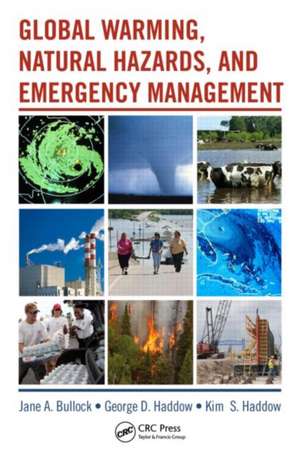Global Warming, Natural Hazards, and Emergency Management
Editat de George Haddow, Jane A. Bullock, Kim Haddowen Limba Engleză Paperback – 20 oct 2008
Frontline Advice for Increasing Defenses and Reducing Impacts of Global Warming
Authored and edited by emergency management and environmental protection professionals from the Federal Emergency Management Agency (FEMA) and the Sierra Club, this book offers case histories from communities across America that have successfully reduced the extent and consequences of natural disasters. These examples are becoming increasingly important to understand and replicate as the risks to communities created by a changing climate rise.
This book recognizes three fundamental principles essential to developing a disaster-prevention strategy:
- The protection of natural systems is an important security measure
- The reduction of disaster risk, not just response, is of great importance
- Local communities must take the lead in prevention efforts
This no-nonsense reference is a procedural roadmap for emergency managers, policy makers, and community officials. It explains how to develop community partnerships among a myriad of stakeholders; identifies staffing and resource requirements for successful programs; and provides a step-by-step demonstration of the disaster-planning process at the community level.
| Toate formatele și edițiile | Preț | Express |
|---|---|---|
| Paperback (1) | 583.66 lei 6-8 săpt. | |
| Taylor & Francis – 20 oct 2008 | 583.66 lei 6-8 săpt. | |
| Hardback (1) | 1209.56 lei 6-8 săpt. | |
| Taylor & Francis – 21 aug 2017 | 1209.56 lei 6-8 săpt. |
Preț: 583.66 lei
Preț vechi: 686.66 lei
-15% Nou
Puncte Express: 875
Preț estimativ în valută:
111.70€ • 121.29$ • 93.83£
111.70€ • 121.29$ • 93.83£
Carte tipărită la comandă
Livrare economică 22 aprilie-06 mai
Preluare comenzi: 021 569.72.76
Specificații
ISBN-13: 9781420081824
ISBN-10: 1420081829
Pagini: 298
Ilustrații: 73 b/w images and 1 table
Dimensiuni: 156 x 234 x 18 mm
Greutate: 0.41 kg
Ediția:1
Editura: Taylor & Francis
Colecția CRC Press
Locul publicării:Oxford, United Kingdom
ISBN-10: 1420081829
Pagini: 298
Ilustrații: 73 b/w images and 1 table
Dimensiuni: 156 x 234 x 18 mm
Greutate: 0.41 kg
Ediția:1
Editura: Taylor & Francis
Colecția CRC Press
Locul publicării:Oxford, United Kingdom
Public țintă
ProfessionalCuprins
The Case for Adaptation (Risk Reduction). Planning and Protecting the Environment. Federal Mitigation Programs: Collateral Stimulus to Reducing the Impacts of Climate Change in our Communities. Community-Based Hazard-Mitigation Case Studies. County/Regional-Based Hazard-Mitigation Case Studies. Conclusions and Recommendations. Appendix: Compilation of Reports, Web Sites, and Other Materials Related to Climate Change.
Recenzii
The book’s case study of flooding in Tulsa, Oklahoma, is particularly instructive of the tenacity and long-term political involvement needed to deal thoroughly with even the most obvious and universally acknowledged hazard . . . offers a wide variety of additional resources on climate change and hazards . . .
– In Natural Hazards Observer, March 2009
– In Natural Hazards Observer, March 2009
Notă biografică
George Haddow, Jane A. Bullock, Kim Haddow
Descriere
Due to the damage caused by global warming, scientists predict that the frequency and severity of weather-related disaster events will increase dramatically. This book provides a clear procedural roadmap for emergency managers, policy makers, and community officials, demonstrating how to reduce the impacts of future disaster events that may be intensified by the effects of global warming. Case studies describe real-world experiences in community-based hazard mitigation and illustrate how efforts should be designed and implemented. The authors explain how to develop community partnerships that include all stakeholders and they identify staffing and resource requirements for successful programs.
















